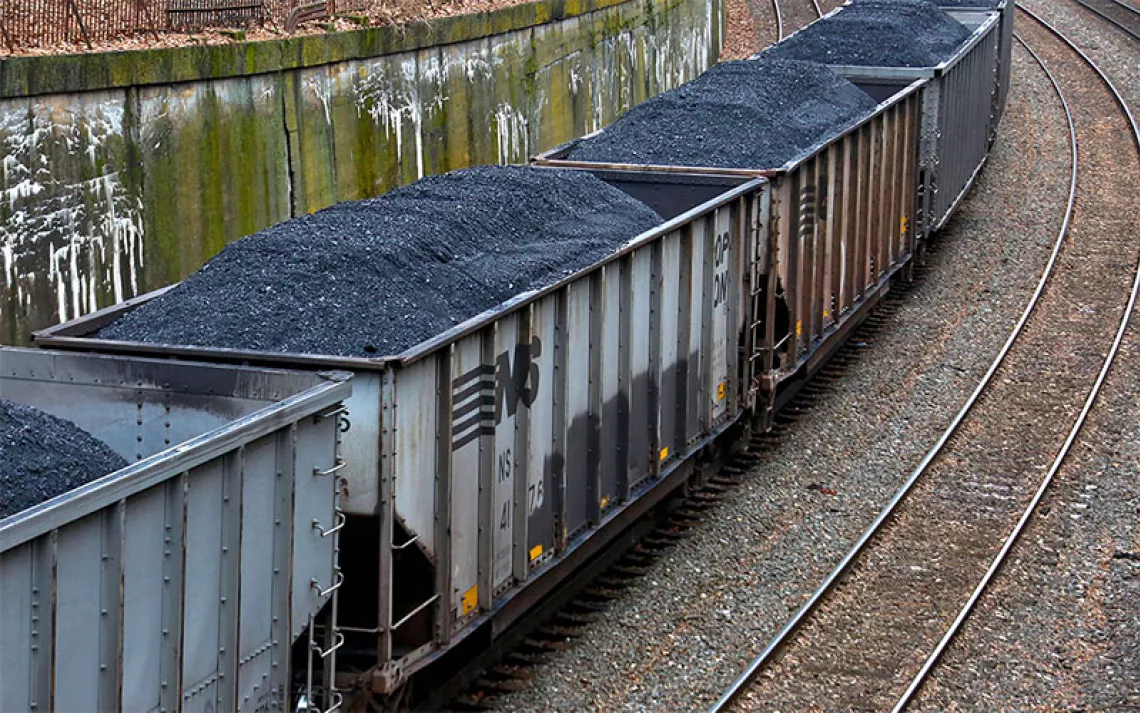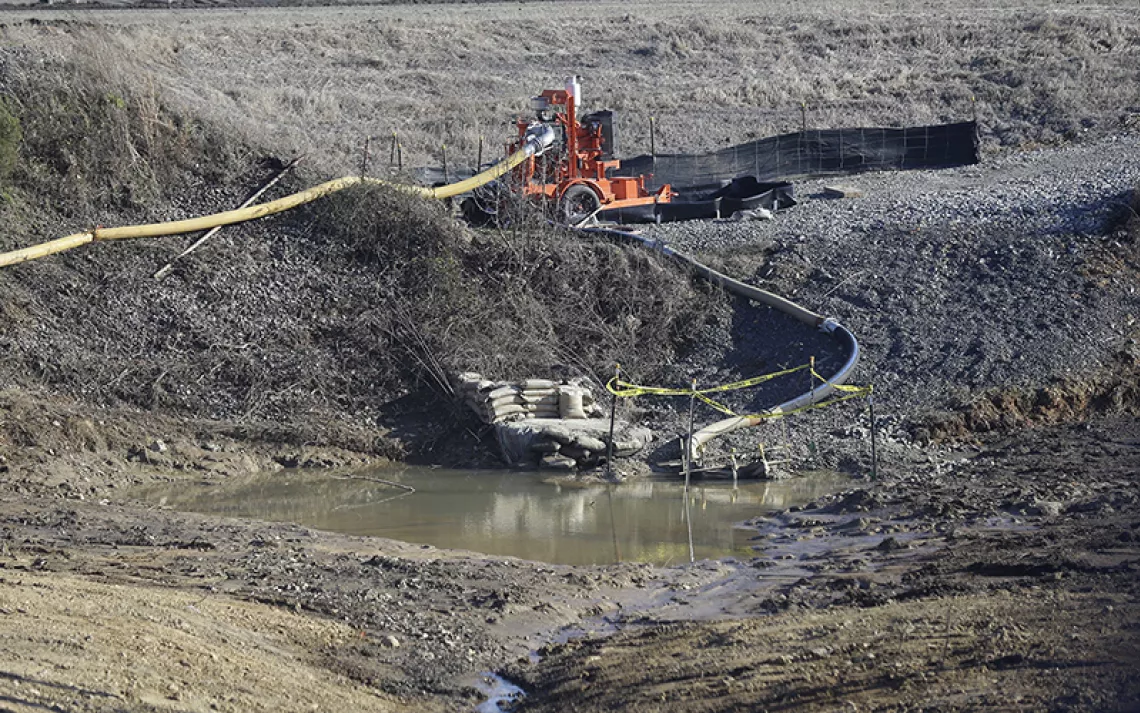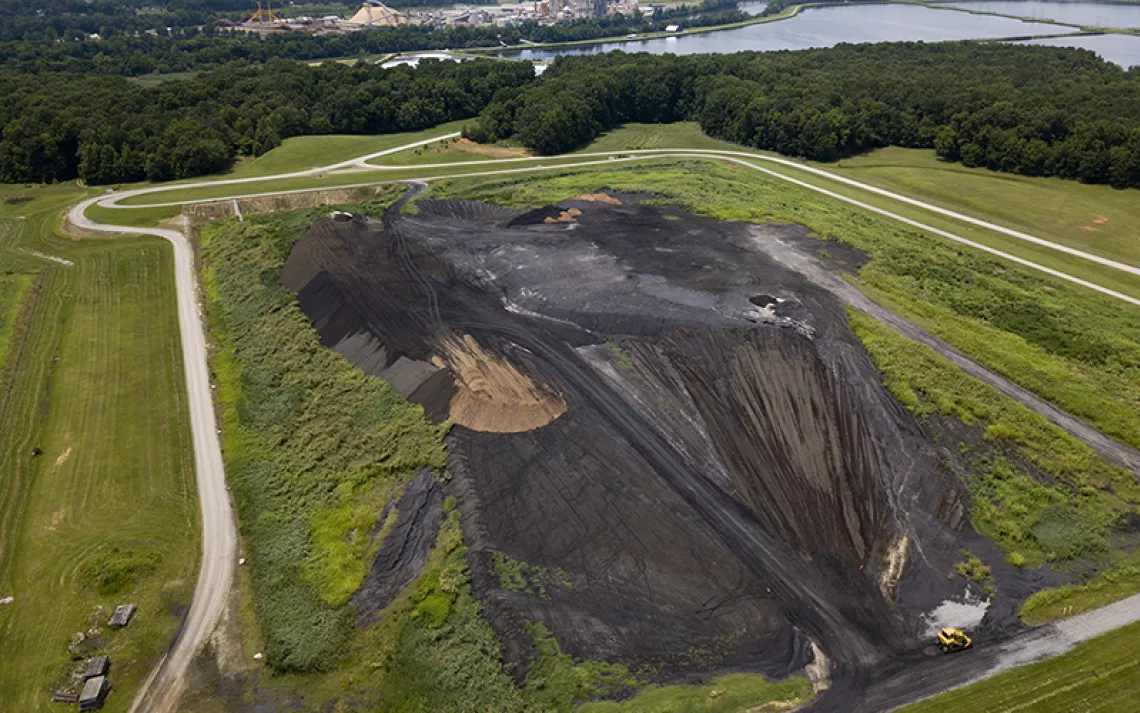Can Harvesting Rare Earth Elements Solve the Coal Ash Crisis?
Over 3 billion tons of coal ash occupy more than 1,400 sites across the US
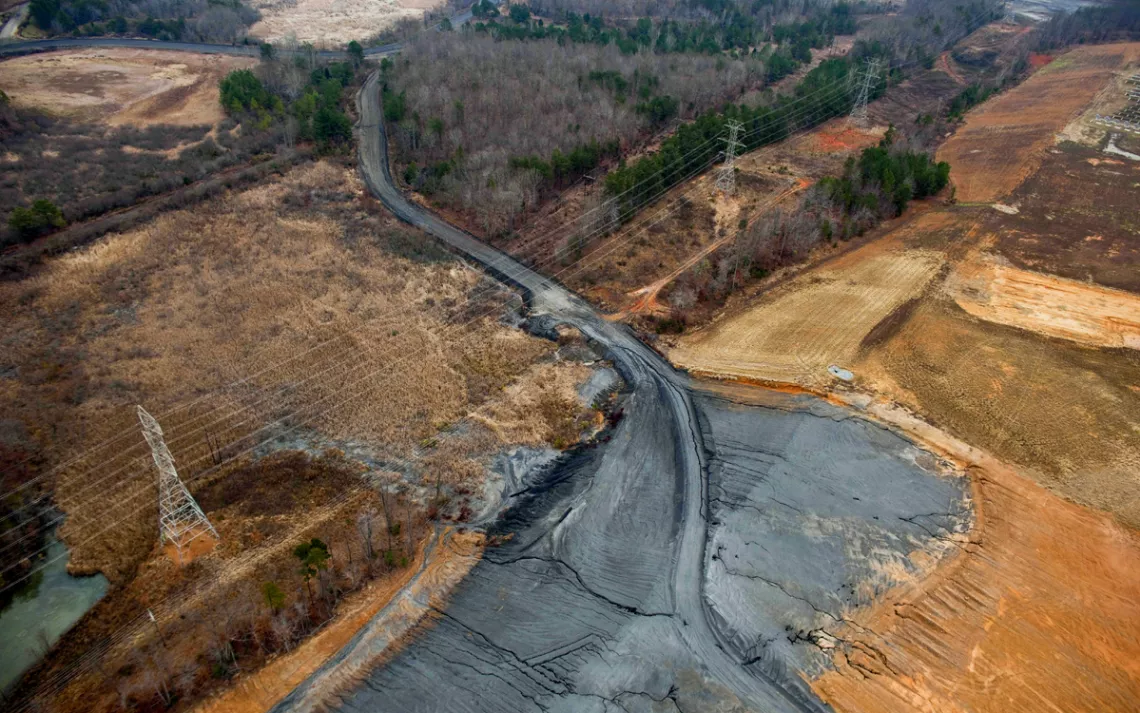
Coal ash waste from the Marshall Steam Station in Salisbury, North Carolina. | Photo by Les Stone
TWO DECADES AGO, Jim Winner went on a spending spree. Flush with cash from the Club, a steering-wheel locking device he helped develop, Winner purchased Gown Town—a glossy five-story building in his hometown of Sharon, Pennsylvania, boasting "the world's largest off-price fashion store." He also bought Donna's Diner next door, a Happy Days–era restaurant with polished aluminum, and crowned it with a neon sign announcing "It's a Winner." Then he bought a Superfund site.
On this October day, I'm driving to the site to learn more about one of the entrepreneur's last ventures before he died: an ambitious gambit to clean up the wastewater streams from Appalachia's mining, oil, and gas industries. On the way, I pass through the color wheel of rural Pennsylvania in autumn: Wine-red staghorn sumacs and purple ironweed line the ditches; thin fences of cattails and swatches of goldenrod ring the wetlands; dried cornstalks stand like sandpaper palms. Between red barns and clapboard farmhouses, horse-led Amish buggies clop down rural roads like charcoal spools. Dark clouds of starlings shape-shift across the horizon.
Amid this patchwork of farm fields fortified with gray matchstick forests sits two centuries' worth of waste from the coal industry. Since the United States began burning coal on an industrial scale in the 19th century, upwards of 35 percent of the immolated material has fallen to the bottom of boilers as ash. That ash has then been removed, mixed with water, and placed in ponds and landfills. Over 3 billion tons of it now occupy more than 1,400 sites across the United States. According to the industry's own data, over 90 percent of these sites contaminate groundwater with almost two dozen heavy and radioactive metals—including arsenic, lead, mercury, selenium, and radium—at levels exceeding the EPA's health standards. A 2014 EPA study revealed that living next to a coal ash waste site increases one's risk of getting cancer from drinking groundwater laced with arsenic.
Because of a dubious system engineered by industry groups, coal ash isn't regulated as hazardous waste. Instead, the material sits in ponds that are "completely archaic," according to Dave Rogers, the southeast deputy regional director for the Sierra Club's Beyond Coal campaign. "You dig a pit, throw coal ash in there, and pour some water on top so the dust doesn't spread, and that's how we've dealt with it for decades."
The Superfund site Winner purchased was a former Westinghouse facility the size of 12 city blocks, polluted after years of use as a steel mill, then a torpedo factory. Winner bought the site with the intent to revitalize downtown Sharon. Today, it's a hodgepodge of small businesses: artist studios, tumbling gyms, corporate meeting rooms, and the headquarters of Winner Water Services—a research hub that promises to not only clean up Pennsylvania's coal-waste dumps but also make a profit doing it.
The steady decline of the coal industry got Winner thinking about reclamation as a lucrative opportunity. In 2005, he hired Todd Beers to manage Winner Water Services and promised that the pollution in many Appalachian waterways could be remediated and repurposed simultaneously—a venture that has since evolved to include mining that pollution for rare earth elements.
But is rare earth extraction a viable solution to the nation's coal ash crisis, or is it just another form of mining the problems of the past for future profits?
I MEET UP WITH BEERS in the parking lot of the old Superfund site. He has a fatherly air and greets me warmly. Beers is a local guy who grew up on a hobby farm 100 miles east of Sharon. When he was 11, his parents leased a small section of their horse pasture for an underground coal mine. Their well water soon turned orange. The mine owners installed a passive water-treatment system—a low-cost, long-term solution to cleaning the family's drinking water. Beers, fascinated by the series of pipes and drainage systems circling the well like a nest, found his calling in reclamation work.
We weave through Winner's warehouse while Beers talks about what his latest research project could mean for his community.
"As the coal industry stopped, there was nothing to replace it with," Beers says. "Having something like this, where you can make a valuable commodity from that byproduct, would be a real shot in the arm."
"This" is creating a domestic supply of rare earth elements—a clump of 17 hard-to-pronounce metallics at the base of the periodic table—from coal ash waste. Rare earths coexist with other elements throughout the earth's crust, but unlike coal, which is compressed into thick ribbons, they're more dispersed and difficult to separate from surrounding ore. In 1999, the same year Winner invested in the Westinghouse site, a geologist named Jim Hower quantified the rare earth elements in eastern Kentucky's coal ash. At the time, Hower wasn't just looking for rare earths, which weren't yet in high demand. He published a paper and moved on.
But in the early aughts, everything changed. In 2007, the iPhone was born, with dazzling capabilities made possible in part by rare earth elements. Today, they can be found in everything from speaker systems to windshield wipers. The speed of the accompanying technological revolution was matched only by that of the unmitigated climate crisis. Moving forward, we need renewable energy to power not only our virtual world but also electric vehicles and the batteries needed to store energy from wind and solar. These technologies, and our clean-power future, require rare earths.
Over the past five years, the US Department of Energy has invested millions in finding these critical elements in coal waste, including in Sharon. Hower, Beers, and the rest of the team at Winner Water Services are part of one of four pilot programs that are competing to scale up to commercial size. Beers leads me down a set of metal stairs to the basement of the warehouse, which, bookended by tall concrete pillars and covered by a two-foot-thick domed roof, looks like a train terminal. The basement is so cavernous, it has a microclimate; icicles hang like stalactites beneath the windows.
Between two pillars, giant plastic sheets rise dozens of feet in the air, protecting Beers's research hub. The other side of the room looks like the back end of a brewery, with silver tanks the size of Smart cars linked together by industrial pipes. The end of this assemblage is where Beers and a small team of chemists mix coal ash with acid to leach out microscopic bits of rare earths. Nearby, Hower's coal ash—roughly 16 tons of it—sits on skids, waiting in the wings for its second life.
"I remember there was a science teacher who told me in my lifetime we'd eventually go back in and mine landfills. That always stuck with me," Beers says. He uncaps a small plastic bottle holding a sample of rare earths; the crumbly mixture looks a bit like powdered gold.
Figuring out how to upcycle the country's coal ash would be a game changer. When coal utilities shut down, billions of tons of toxic coal ash can be abandoned in place. The question of what to do with the waste—how to clean it up and, for some, how to capitalize on it—has led to a whole industry based on its reuse. Beers could be holding one of that industry's most promising solutions in the small bottle in his hand. Instead of mining and incinerating coal to generate electricity, the coal economy of the future could take the form of cleaning up and mining the industry's historic waste.
Still, while projects like this one in Sharon can process tons of coal ash at a time, no project has been scaled up to handle the remediation of billions more.
A FEW DAYS LATER, Hower zings into the Zoom square of my computer screen for a tour of his office at the University of Kentucky Center for Applied Energy Research. At 69, he has been coal ash's geologic leader for over 40 years and is keen to talk about anything and everything related to coal ash. He's wearing a crimson Pottsville Maroons T-shirt—a 1920s-era National Football League throwback from the anthracite fields of eastern Pennsylvania, where Hower is from—to mark the occasion.
Hower quickly lays out the big picture of how the University of Kentucky and Winner Water Services work together: First, Hower chooses the coal ash with the highest concentration of rare earths. Then, his research partner, a mineral engineer from the university named Jack Groppo, does the physical processing. Groppo uses magnets, mesh screens with minute holes, and a system called froth flotation to refine the coal. The pair ship their fine, feather-light, finished product to Beers, who leaches out the payload. All three report to a Massachusetts group called Physical Sciences Inc., or PSI, which invented the original laboratory model for the research and owns the intellectual property. PSI is a private company that creates a wide range of technologies, from methane-leak detectors to hypersonic planes.
Hower pans his phone camera across his office to show off his prized possessions: a giant, flying-saucer-like orb of pyrite; chunks of bottom ash ranging in size from paperweights to rough-edged basketballs; a flat limestone rock with a delicate fern. Behind this miniature museum, tall black filing cabinets and cardboard boxes are stacked like beehives. Every drawer contains fossil evidence that took millions of years to form but was then harvested at some point over roughly two centuries by the coal industry.
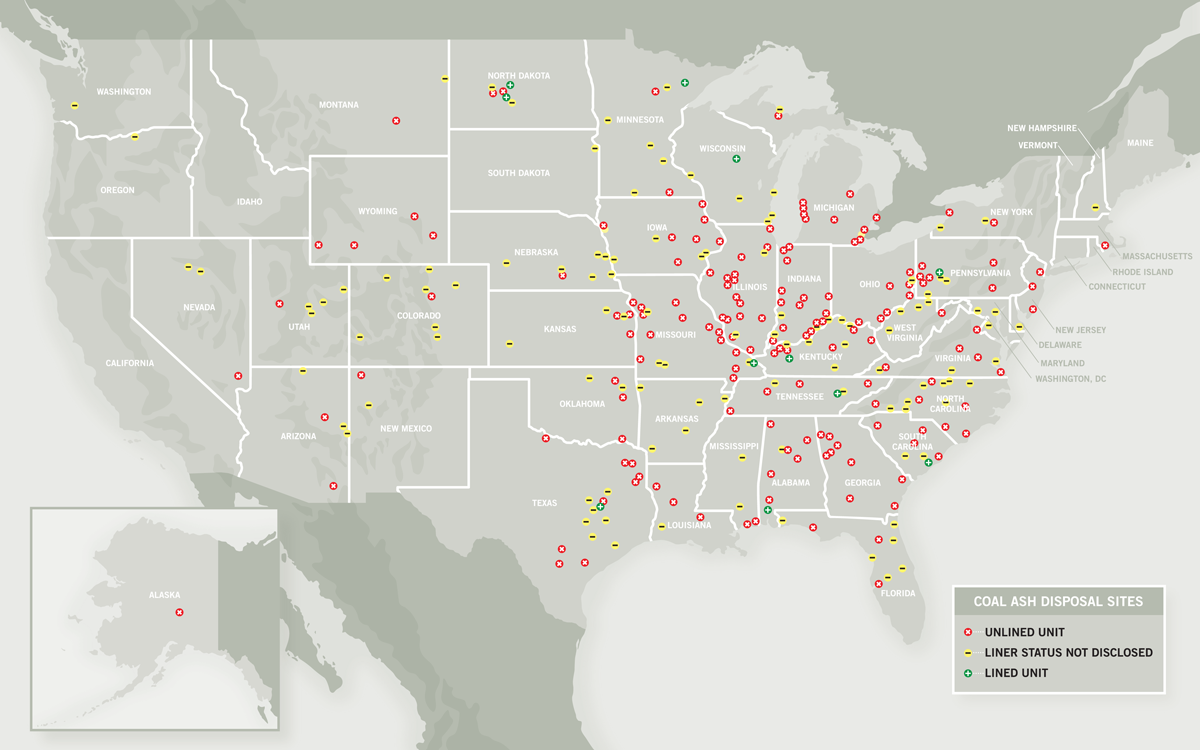
Map by Brown Bird Design. Source: Earthjustice.
"You can only mine a ton of coal once, and they mined all the best stuff first," Hower says. "It's a natural progression in any sort of resource like that, that you'll run out. It's not renewable in anyone's lifetime." He moves the phone to a microscope, underneath which a handmade coal ash pellet transforms into a galaxy. In the center, the glass looks like a bright-white moon; magnetite becomes blue Milky Way dust; anonymous elements sparkle across the screen like stars.
Coal ash has been spread out across the country, not only in ponds and landfills but also in a complex, largely unchecked network of reuse. The question of what to do with this waste—intern it, reuse it, or extract critical minerals like rare earth elements from it—is the latest predicament facing the coal industry.
Between 1966 and 2017, coal-mining companies and utilities dumped more than 4 billion tons of coal ash across the United States. Since the 1970s, approximately 1.5 billion tons of coal ash has been put to "beneficial use," a greenwashing term adopted by the American Coal Ash Association, an industry group that promotes the goal of reusing 100 percent of coal ash.
"'Beneficial use' is a term that can contain a wide range of sins as well as good acts," Frank Holleman, the director of the Southern Environmental Law Center, says. "Sometimes what they mean by beneficial use is to stick it in the ground somewhere else in an unlined pit and call it fill. Well, that's just scattering pollution with heavy metals across a landscape where it's even harder to get records of it and monitor it."
Increasing the scope of beneficial use rids utilities of one of their biggest liabilities: the coal ash waste they've left behind as their units have shuttered. It can save utilities money, reducing the need to build modern, properly lined landfills to store the dry ash high above the water table and away from local communities. Georgia Power, for example, has devoted 2 million tons of its leftover ash to beneficial use as a cement replacement for making concrete. In 2020, the utility partnered with the Electric Power Research Institute to open the Ash Beneficial Use Center, which runs pilot programs and experiments with new technologies to recycle coal ash.
According to Lisa Evans, an Earthjustice attorney and coal ash expert, "every ton of coal ash that they [the utilities] don't have to dispose of in ponds or landfills is pennies or dollars in their pocket."
UPCYCLING COAL ASH isn't a new concept. In its physical characteristics, coal ash is similar to the volcanic ash that Romans used in concrete to build the Colosseum and the aqueducts that still curve through Rome. Their ash was harvested near Pozzuoli, Italy, a region shadowed by Mt. Vesuvius. Today, the properties in ash that make concrete more durable and long-lasting are described as pozzolanic. As early as the 1940s, coal ash's pozzolanic structure was used to strengthen dams including the Hungry Horse Dam in Montana and the Hoover Dam, bridging Arizona and Nevada.
This EPA-approved form of waste recycling—reusing coal ash as a replacement for portland cement in concrete dams and bridges—is called encapsulation. In 2019, over 70 percent of the coal fly ash that was reused was encapsulated in concrete. The method is endorsed by green groups like the Natural Resources Defense Council, the Green Building Council, and Earthjustice because it lowers greenhouse gas emissions associated with mining new cement and disperses the ash, protecting air and water from its concentrated impoundments. But according to Holleman, "once we get past cement and concrete, you have to look very carefully and skeptically."
Perhaps the worst form of reuse is "structural fill"—a term the EPA uses to refer to the mountains of coal ash dumped across both lined and unlined landscapes. Long criticized by environmental groups as one of the most damaging forms for public health and the environment, structural fill is the most prominent use for unencapsulated coal ash. The ash is used in the foundations of houses, underneath driveways and roads, and in public parks and golf courses. It's also used to bolster embankments and fortify defunct mines.
These practices of reusing coal ash waste went unregulated for decades until 2015, when the EPA under the Obama administration finalized the first-ever federal regulation of coal ash. Known as the Coal Ash Rule, the regulation was immediately contested by industry and environmental groups, with the former claiming it went too far, the latter that it didn't go far enough (for example, it failed to define coal ash as hazardous waste). Still, the new rule offered long-overdue protections.
The EPA described the unencapsulated placement of coal ash as "akin to disposal" but "under the guise of 'beneficial use.'" The damage from unencapsulated coal ash disposal, the EPA found, resulted in "by far the largest number of documented cases in the history of the RCRA program [the federal law monitoring waste disposal]." Of the EPA's 158 reports of coal ash contamination with high pollutant releases, at least 22 of the cases were caused by fill. At nearly half these fill sites, coal ash had contaminated drinking water above the EPA's health standards.
One example is Pines, Indiana. The town's nearby coal plant began disposing of its coal ash by distributing it across Pines—filling wetlands, lining driveways, and constructing roads. Pines became a Superfund site—its groundwater was polluted with over half a dozen contaminants, including arsenic, lead, and selenium.
"There's a huge record that would lead any reasonable person to the conclusion that using unencapsulated coal ash as fill is way too dangerous," Evans says.
The restrictions laid out in the 2015 Coal Ash Rule were minimal. Even so, in 2018, the Trump administration tried to roll them back (its proposal for doing so is still tied up in court). Without regulatory controls or oversight, the placement of ash on or in land isn't subject to public notice, monitoring, dust control, or any safeguards that protect community and environmental health.
"It's pretty sad that over the years the regulation in this country and many other countries has not correctly addressed coal ash and what's in coal ash," says Avner Vengosh, a Duke University professor of earth and ocean sciences. "Even those [2015] rulings did not fully address issues of coal ash, and ironically the EPA [under the Trump administration] is now running back from those compromised rulings."
The American Coal Ash Association reported that between 2000 and 2017, 118.4 million tons of coal ash became fill, enough to bury Kentucky in three feet of solid waste. But even this vast amount is a gross underestimation. The ACAA only compiles the tonnage that companies voluntarily report. Further, the EPA doesn't track fill applications, and "structural fill" doesn't include other land placements like agricultural use, soil amendments, and snow and ice control.
In response to questions, an ACAA spokesperson told Sierra, "consensus-based engineering standards developed over decades of experience ensure that properly constructed structural fills are safe."
The United States produces a lot of coal ash, but the amount of rare earths extracted from coal refuse is still incredibly slight compared with what's extracted through traditional mining. According to Hower, it takes five metric tons of coal ash to produce one kilogram of rare earth elements, depending on the concentration. The average concentration of rare earths in coal ash is 500 parts per million, while the concentration of rare earths in mined ore is about 40 times that. The economics of extracting 500 parts per million of rare earths doesn't, on its own, make sense.
Back in Pennsylvania, Beers tells me to think of coal ash as like a marble. "Those salt seams in the marble is what we're trying to extract out," he says. The rest of the marble is left behind.
Across from the silver tanks, filter socks filled with coal ash are stacked like giant slugs along the plastic wall. The dried ash left over from the leaching process can be reused as a replacement for portland cement. Although this test amount is too small to sell and will likely be trashed, the cement-approved pile represents a huge breakthrough. The ash, once depleted of rare earths, can be repurposed again, and in an encapsulated form.
"It's not just about making rare earths," Beers tells me. "You have to be able to use the ash beyond the rare earth extraction because there's just so much of it. If you have to waste that, you've created another cost."
But some researchers, including Helen Hsu-Kim, an environmental engineer at Duke University, feel that the push for rare earths may not be a reliable long-term solution for coal waste. "People talk about [schemes like] mining the deep ocean for rare earths," she says. "Coal is just the latest one."
HOWER AND GROPPO have long had ties to the American Coal Ash Association. Since 2005, the University of Kentucky Center for Applied Energy Research has held joint biennial conferences with the ACAA called World of Coal Ash. Their 2019 meeting in St. Louis attracted roughly 1,000 attendees. Although Groppo argues that coal ash reuse can be sustainable, he isn't always in agreement with the environmental movement. He isn't convinced of humans' role in climate change and dismisses arguments about coal ash resulting in pollution as based on fearful emotions, not facts. Some consider the University of Kentucky, where Hower and Groppo work, an industry think tank because much of its funding is derived from the coal industry.
For the Sierra Club's Rogers, even reusing coal ash via encapsulation in concrete is problematic. The ash has to be reprocessed to remove carbon, which means refiring the ash, leading to more emissions and pollution in local communities.
"The reality is, regardless of what people [like members of the ACAA] think, coal ash contains cancer-causing chemicals and toxic substances. We should deal with it as such," Rogers says. "It's essentially adding an additional burden to the very communities that have borne the brunt of our reliance on coal for decades already."
In the future, coal may be managed in much the same way that Winner, Beers's deceased boss, managed his business: with a keen eye for whatever profit can be extracted from its waste. A fraction of coal ash—one part out of 2,000—contains rare earths, but the rest is still up for grabs in a myriad of different profit streams, like concrete and structural fill, that both utilities and the ACAA would like to continue to exploit.
In spite of the considerable challenges, Beers remains idealistic—he believes that the coal economy can come full circle through new reuse applications. While we walk toward the end of the warehouse, he describes witnessing the boom and bust of the coal economy in western Pennsylvania. He wants its waste stream, through his work at Winner Water Services, to provide new jobs in his region.
At the end of the warehouse, two big double doors open up to a clear blue sky. The Shenango River rolls below. According to Beers, about 7,000 miles of Pennsylvania streams are completely devoid of aquatic life owing to coal mine waste. Earlier in his career, he built upstream treatment systems for the region's rivers. He wants to keep solving problems similar to the ones his family faced when he was a child.
"We have this heritage of industrial operation, and it's left us with a lot of things. A lot of good and some bad," Beers says. "How do we take that and do the best we can with what we've been left?"
This article appeared in the March/April edition with the headline "From the Ashes."
 The Magazine of The Sierra Club
The Magazine of The Sierra Club
